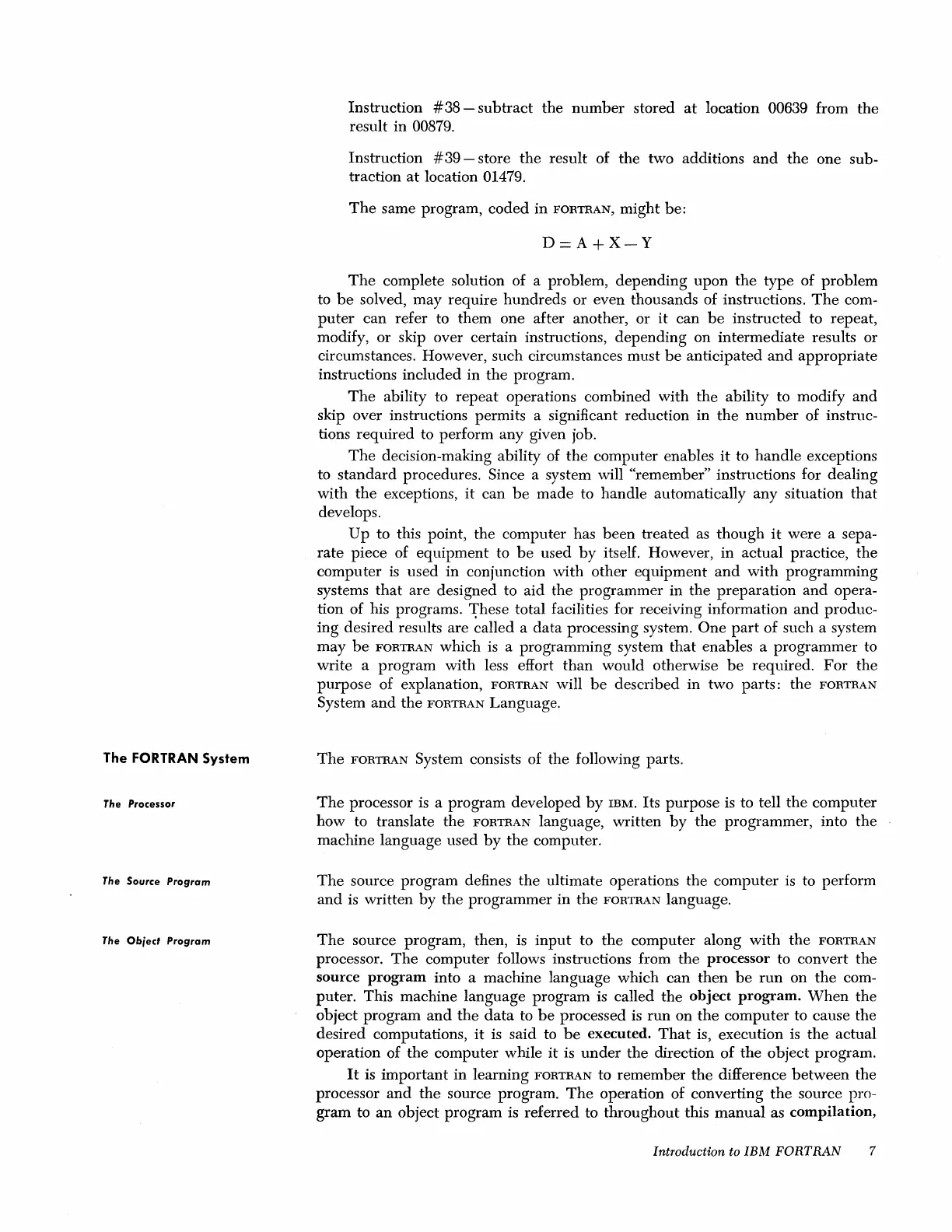The FORTRAN System
The Processor
The Source
Program
The
Ob;ect
Program
Instruction # 38 -
subtract
the
number
stored
at
location 00639 from
the
result in 00879.
Instruction
#39
- store
the
result of
the
two
additions
and
the
one sub-
traction
at
location 01479.
The
same program,
coded
in
FORTRAN,
might
be:
D=A+X-Y
The
complete solution of a problem,
depending
upon
the
type
of
problem
to
be
solved,
may
require
hundreds
or even thousands of instructions.
The
com-
puter
can
refer to
them
one
after another, or
it
can
be
instructed
to repeat,
modify, or skip over certain instructions,
depending
on
intermediate
results or
circumstances. However,
such
circumstances
must
be
anticipated
and
appropriate
instructions
included
in
the
program.
The
ability to
repeat
operations combined
with
the
ability to modify
and
skip over instructions permits a significant reduction
in
the
number
of instruc-
tions
required
to perform any given job.
The
decision-making ability of
the
computer
enables
it
to
handle
exceptions
to
standard
procedures. Since a system will "remember" instructions for dealing
with
the
exceptions,
it
can
be
made
to
handle
automatically any situation
that
develops.
Up
to this point,
the
computer has
been
treated
as
though
it
were
a sepa-
rate
piece
of
equipment
to
be
used
by
itself. However, in
actual
practice,
the
computer
is
used
in
conjunction
with
other
equipment
and
with
programming
systems
that
are designed to
aid
the
programmer
in
the
preparation
and
opera-
tion of his programs.
1hese
total facilities for receiving information
and
produc-
ing
desired results
are
called a
data
processing system.
One
part
of such a system
may
be
FORTRAN
which is a programming system
that
enables a
programmer
to
write a
program
with less effort
than
would otherwise
be
required.
For
the
purpose
of explanation,
FORTRAN
will
be
described
in
two
parts:
the
FORTRAN
System
and
the
FORTRAN
Language.
The
FORTRAN
System consists of
the
following parts.
The
processor is a
program
developed
by
IBM.
Its
purpose
is to tell
the
computer
how
to translate
the
FORTRAN
language,
written
by
the
programmer, into
the
machine language
used
by
the
computer.
The
source program defines
the
ultimate operations
the
computer
is
to perform
and
is
written
by
the
programmer
in
the
FORTRAN
language.
The
source program, then, is
input
to
the
computer
along
with
the
FORTRAN
processor.
The
computer
follows instructions from
the
processor to convert
the
source
program
into a
machine
language which
can
then
be
run
on
the
com-
puter.
This machine
language
program
is called
the
object
program.
When
the
object
program
and
the
data
to
be
processed is
run
on
the
computer
to cause
the
desired computations,
it
is said to
be
executed.
That
is, execution is
the
actual
operation of
the
computer
while
it
is
under
the
direction
of
the
object
program.
It
is
important
in
learning
FORTRAN
to
remember
the
difference
between
the
processor
and
the
source program.
The
operation of converting
the
source pro-
gram
to
an
object
program
is referred to
throughout
this
manual
as compilation,
Introduction to
IBM
FORTRAN
7
